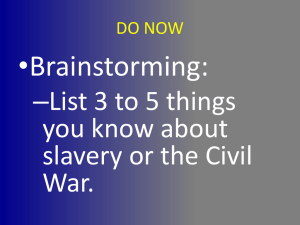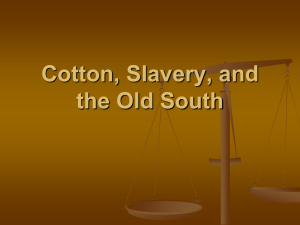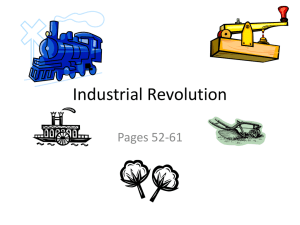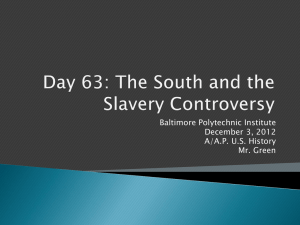Ch 11 Notes
advertisement
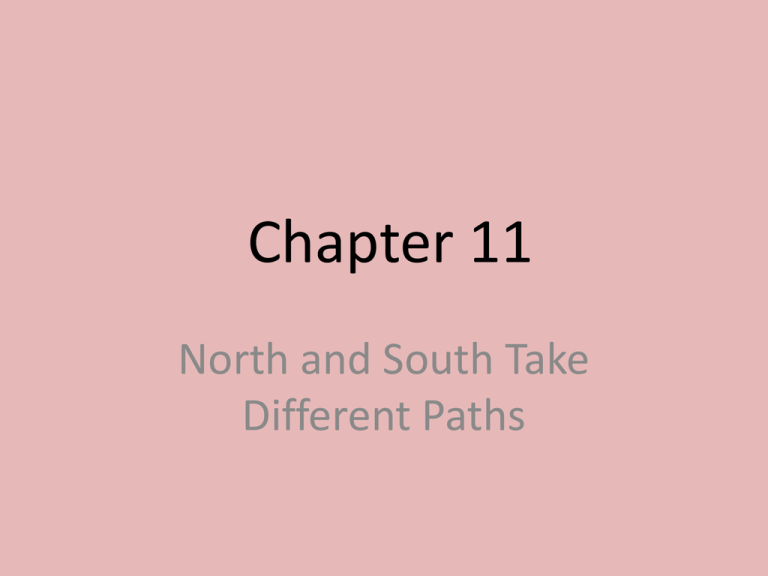
Chapter 11 North and South Take Different Paths Warm up (Briefly answer all 3 questions…we will discuss as a class.) Questions: 1. Before stores and factories, how did people get materials that they needed? 2. What daily household items would be the most difficult to make/build? 3. How have factories made life easier? Answer: 1. Before stores and factories, how did people get materials that they needed? A: hand made, traded with neighbors 2. What daily household items would be the most difficult to make/build? A: clothes, furniture, dishes 3. How have factories made life easier? A: They mass produce items, cheaper, faster The Industrial Revolution Section 1 What was the Industrial Revolution? The Industrial Revolution was a time when new inventions and new lifestyles ruled. These new inventions made factories much more important. Machines took the place of hand tools. Along with the new inventions came the increased desire for city life and factory jobs. Production and transportation became faster and easier too! During the Industrial Revolution, people moved from working in homes and farms to working in mills and earning wages. This was brought on by new ways of working as well as new ways of producing goods. The Industrial Revolution began in New England New Hampshire Vermont Massachusetts Rhode Island Connecticut Why New England? • The poor soil • The many rivers and streams • Geographical location (coal and iron) • Sea ports • Money In Great Britain, they developed… • Spinning jenny and the water frame spun thread • Power loom wove the thread into cloth Saves time and money! Inventions The Spinning Jenny Powered Loom Steam Power • Factories had to be built near a water source to operate, but during the dry season the machines didn’t have power. • To solve this problem a steam engine was designed to allow factories to be built anywhere. Sir Richard Arkwright Francis Cabot Lowell • A wealthy man, who went to Great Britain brought factory systems to the United States • A factory system = bringing manufacturing steps together in one place to increase efficiency. They used mass production & interchangeable parts to increase production. • 80% of the workers in Lowell’s mills were young unmarried women between the ages of 15-30 • Conditions were poor: • Low wage • Long hours • Monotonous work •• Interchangeable Created parts were interchangeable uniform parts parts made while in trying largetoquantities meet a that manufacturing could replace deadline. any other identical pieces • Leads to mass production and reduction in cost. Children In Factories • Prior to the Ind. Rev. kids worked on family farms. • Once factories were created, children worked many hours in the factories. • Kids as young as 7 worked in unsafe conditions and had no chance to go to school. Factory Conditions • Factory conditions were horrible. • No fresh air • Dangerous machines • On the job injuries didn’t get compensated Warm up: Question: Why were the Lowell Mills important to the American economy? Answer: • Lowell Mills created a factory system. A factory system brought manufacturing steps together in one place to increase efficiency. They used mass production & interchangeable parts to increase production. Mill Times Movie Warm up: How did the creation of mills change small towns in New England? Answer: Small towns started to grow around the mills. Citizens started to find jobs in the mills. Section 2 The North Transformed • Huge population growth in the cities (urbanization) •People moved to the cities to get jobs in factories • Lead to problems like: - Overcrowding - Disease - Pollution - Risk of fire - Lack of clean drinking water City life was dirty and overcrowded What do you think the ditch in the center of the photo was used for? Economy • North: relied on industry and technology • South: slavery and cotton was their foundation Industry • North: – Many new inventions allowed the North to produce things efficiently • South: – Agriculture was profitable • Industry was of little use • There was only a small market for manufactured goods • “We want no manufactures; we desire no trading, no mechanical or manufacturing classes. As long as we have our rice, our sugar, our tobacco and our cotton, we can command wealth to purchase all we want.” Communication • North: – Printing press invented • mass production of newspapers – The telegraph was invented (by: Samuel F.B. Morse) • Ran along railroads • Allowed quick communication • South: – due to the limited amount of railways • Less telegraph lines and worse communication than the North Agriculture & Manufacturing • Important inventions: – Mechanized reaper (by: Cyrus McCormick) – Steel-tipped plow (by: John Deere) – The sewing machine (by: Howe & Singer) Transportation • New water transportation – Steamboat (by: Robert Fulton) – Clipper ships • New land transportation – Railroads (Baltimore & Ohio R.R.) – North: all railroads interconnected – South: short, only connected small towns A New Wave of Immigrants Who came and why? • The Great Hunger in Ireland (Over 1 million came to the U.S.) • German Revolutionaries (After failed revolutions many came to the U.S.) Nativists • Mostly American-born Protestants • They feared foreigners…especially Irish, Roman-Catholics • The Know-Nothing political party rose in NYC, policies against foreigners African Americans in the North • African Americans – Faced discrimination in all areas of life • • • • Low wages No suffrage (right to vote) No free public schools Not allowed to work in factories or in skilled trades • Segregated schools, public facilities, and churches Distribution of slaves Census Year # Slaves # Free blacks Total black % free blacks Total US population % black of total 1790 697,681 59,527 757,208 7.9% 3,929,214 19% 1800 893,602 108,435 1,002,037 10.8% 5,308,483 19% 1810 1,191,362 186,446 1,377,808 13.5% 7,239,881 19% 1820 1,538,022 233,634 1,771,656 13.2% 9,638,453 18% 1830 2,009,043 319,599 2,328,642 13.7% 12,860,702 18% 1840 2,487,355 386,293 2,873,648 13.4% 17,063,353 17% 1850 3,204,313 434,495 3,638,808 11.9% 23,191,876 16% 1860 3,953,760 488,070 4,441,830 11.0% 31,443,321 14% 1870 0 4,880,009 4,880,009 100% 38,558,371 13% Source: http://www.census.gov/population/documentation/twps0056/tab01.xls Warm up: Question: What was difficult about living in the city in the 1800’s? Name 3 things. Answer: Problems for people living in the cities: - Overcrowding - Disease - Pollution - Risk of fire - Lack of clean drinking water Section 3 The Plantation South As the North became more urban and industrialized the South remained rural… 1. Textile boom…created a huge demand for cotton 2. Invention of the cotton gin…produced more cotton • Plenty of fertile land • Cotton Gin • Slaves • High demand for products (North) In the United States… In the United States… • Mechanical flour mill Only needed two people to run it. (one to empty the bag of wheat and one to roll away the barrels of flour) • Now 1 = 50! • Cotton Gin a simple machine that quickly removed the cotton seed from the fiber. The Cotton Gin Cheaper to clean makes it possible to make money off of it!!! Farms vs. Plantations Farms (50-200 acres) Plantations (1,000 acres) – Tenant farmers – Domestic slaves – Field workers – Plantation owners • Rented land to farm – Owned by Yeomen (men who did not own slaves) • Largest group of white men in the south • Goal: to earn profit – Plantation wives • Supervised buildings and kept records Slavery developed in the South because of the need for cheap labor. Cotton picking in Mississippi The Life of a Slave European slave traders in Africa did not seize land from natives and colonize the coast, as they did in their New World settlements. Instead, they established special relationships with local chieftains, who allowed them to maintain trading forts along the coast. Local Africans, rather than the Europeans themselves, acquired and supplied slaves to the white traders. African tribes would win wars and sell the captives of the losing tribe into slavery. The first slaves were brought to America in 1619 and typically they had a master for seven years before they were free. However, farmers soon needed slaves for large plantations so they started to buy them for life. The Life of a Slave Slaves were crowded on to ships and brought over to America on Triangle Trade routes. SLAVERY Family Families were often separated by sales. Work Slaves worked from sun up to sun down. – Kids: carried water and easy chores – Elders: cared for young and did light chores – Everyone else: fields -1 out of 4 families in the South owned slaves - 1 out of 7 families owned 10 or more Living Conditions HOMES for slaves were called slave cabins -Mud floors -About 12 to a room -Very dirty Slave Auction: slaves were bought and sold Life as a Slave MARRIAGE:“until death or distance do you part” CULTURE: large families, clothing, songs, dance Life as a Slave PROTESTING: Worked slowly, faked illness, burned buildings, broke tools, made animals lame, escaped (ALL resulted in punishment ) Additional African American Issues • Free African Americansthey faced many problems and were denied basic rights. • Slave Codes- laws that controlled every aspect of an enslaved person’s life. • Resistance to slavery- Nat Turner led a revolt in 1831. About 60 whites were killed in the revolt. Warm up: Question: Who invented the cotton gin and what did it do? Answer: Eli Whitney invented the cotton gin in 1793. The cotton gin’s crank turned a cylinder that drew cotton fibers, but not cotton seeds, through small slots. Section 4 The Challenges of Growth Moving West • Daniel Boone and a group of 30 men cleared the Wilderness Road. It allowed people to cross the Appalachian Mts. and travel westward. • From 1792-1819 8 states joined the Union: – Kentucky, Tennessee, Ohio, Louisiana, Indiana, Mississippi, Illinois, Alabama Roads and Turnpikes (toll roads) • Farmers and merchants needed a faster way to move their goods to market. • Private companies started to build toll roads. ($) • Corduroy roads were also built in marshy areas. (Logs laid side by side) • The National Road (1st federally funded) road began in 1811 in Maryland and stretched to Illinois by 1850. Travel from East to West became easier. Canals • This was the fastest and cheapest way to transport goods. • Major rivers ran N S, the goal was to build the canals from E W to connect waterways • N.Y. Gov. Clinton decided that a canal should be built to connect the Hudson River to Lake Erie. (Locks were necessary) • Canals spurred Midwest business and they were built everywhere. The Extension of Slavery • Slave and Free States-In 1819 there were 11 free states and 11 slaves states BUT Missouri had been trying to become a state since 1817. • Question-How should Missouri be admitted; slave or free state? The North and South fought over the issue! (Balance of the Senate) The Missouri Compromise • Henry Clay proposed a solution to the problem. • Adopt Maine as a free state, adopt Missouri as a slave state and use the southern border of Missouri as a dividing line. N=free and S=slave for states added from the rest of the Louisiana Territory. • Slave owners could also capture run away slaves in free territory. • BUT…should Congress have the power to make decisions about slavery? The Missouri Compromise Warm Up: Question: What was one mode of transportation for a pioneer family heading west? Explain a positive and negative for your mode of transportation. Illinois Central Railroad Answer: Wagons1. Positives- accessible, most people had them 2. Negatives- broke easily, hard to go over the mountains Steamboats1. Positives-improved the transport of goods and passengers along major rivers, shipping goods became cheaper and faster, contributed to the growth of river cities 2. Negative-didn’t have enough power to withstand the strong currents and shifting winds found in large rivers Rail Roads/Trains1. Positive- fast, fairly cheap 2. Negative- didn’t go everywhere Warm Up: Question: Why was the Missouri Compromise important? Answer: • It temporarily settled the debate over slavery in the U.S. • Details of the Compromise: – Adopt Maine as a free state, adopt Missouri as a slave state and use the southern border of Missouri as a dividing line. N=free and S=slave for states added from the rest of the Louisiana Territory. – Slave owners could also capture run away slaves in free territory. Warm up: Question: Why did the North and the South take different paths? Tip: Look at your worksheet from yesterday to help you answer this question. Great Olympian Cotton Mill in Georgia Answer: As business grew, the North focused on industrialized products and jobs that could be done all year round. (Lowell Mills, interchangeable parts) As cash crops flourished the South began to spend more efforts on the crops that would make them money, often over the crops that provided food. (cotton, tobacco) Test Day Please put projects on your desk and be ready to turn them in. Make sure your name is on your project.

